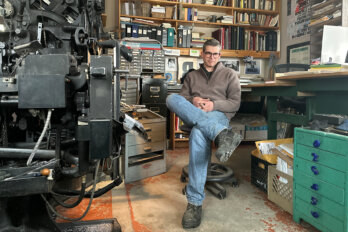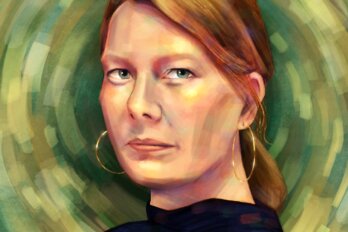There is a shelf labelled “plotless fiction” in the bookstore where I work. It is an object of endless fascination. It jokes, but it’s dead serious. We love it neurotically. A box arrives, a book is released, and a bookseller says to herself: “It’s fiction, but is it plotless?” Customers often ask me what it means, but I never get it right. It has something to do with language, place, sensibility; nothing needs to happen per se, so long as you’re immersed, charmed, consumed. Of late, this shelf has been home to an array of novels by lesbian writers—books that ace this nebulous quality and experiment with language as they consider queerness as a literary and life form, landing on the shortlists for awards, like the International Booker Prize and the Governor General’s Literary Award, and receiving high critical acclaim.
Queer fiction is having something of a moment. Publications like the New York Times and the Guardian have been covering the rise and proliferation of the queer romance genre in particular, with op-eds praising “much needed representation” and happy endings that refute the all-too-common twentieth-century literary trope of coupling queer love with psychosocial ruin. Alongside the boom of more formulaic queer romances, I’ve been noticing a shadow boom in the paperbacked realm of plotless fiction: a weird, cerebral counterpart to this more mainstream trend. Those queer plotless books I loved most this year—a sample size to be sure, but a memorable one—are not engaged, as the romances are, in reimagining queer endings. Instead, they speak to queer ongoingness. Awake to the ways in which queer people have long carved new models for conducting life outside of heterosexual narratives, these books are invested in the ways one flips the script on the page, imposes one’s will, creates something new.
If queer plotless fiction had a patron saint, it might be Renee Gladman. Her work is more or less category resistant, drawing on art, architecture, and fantasy and pressing theory onto narrative to tell stories that are as much about language as about people. In her latest book, My Lesbian Novel, published last fall by indie press Dorothy, a publishing project, she casts queer romance as an experimental form. The novel’s central figure, a writer named “Renee,” is featured in conversation with an unnamed interviewer as they discuss her attempt to pen a lesbian love story. Renee’s interlocutor is indispensable to the production of her romantic text: “How will you start the novel you wish to write?” they ask, and Renee begins. Their conversation is repeatedly interrupted by swaths of book—“we talk then I write”—and the reader is fed portions of a novel that will only ever exist in fragments, one which follows a woman named June who is dating a man named Ellis but engages in flirtation with a woman named Thena. The author Renee might be the character Renee and the character Renee might be her character June, but it’s never settled. The distinction between reality and fiction is amorphous.
The interview is interrupted by a five-year break, during which the project is upturned. Initially, Renee wants to write a lesbian romance as a course correction for The Well of Loneliness–style gay literary devastation, but in the intervening years, she discovers an existing genre of lesbian “HEAs,” happily ever afters, “being written now and profusely so”—titles that prop up the book industry’s more profitable arm of romance fiction. The real-world analogues might be playful queer bestsellers like Samantha Irby’s quippy We Are Never Meeting in Real Life, Jenny Fran Davis’s irreverent Dykette, and anything and everything by Casey McQuiston, works that are being bought up by major publishers. Renee reads hundreds of these books and becomes an expert in their affects and eccentricities. “In lighter novels, there’s a great deal of the rolling of the eyes, which I like,” she writes, so that stays. “I am a sucker for women carrying each other around.” Original purpose moot, Gladman steals aspects of other romances, embedding them into her increasingly experimental work. My Lesbian Novel becomes its own kind of romance, its unfinished state “more desire than reality,” its taste for pastiche an acknowledgment of how love stories accumulate, new romances refracting old ones.
You could observe the way Gladman has “queered the novel”—broken it apart, rejected its orthodoxies, and troubled assumptions about relationships—and also the way she has queered the contemporary lesbian romance, taking its most charming features and installing it into a totally other format. But more crucial for Gladman is the way the novel serves as an architecture for thought, a site where the mind is given free range. Thinking becomes newly possible once it is relocated in the literary, where reality and invention collide, where one “curls over” the next. Renee says: “the story of my writing [this book] is almost more integral to my living than what it may or will become.” The writing of the novel and the novel itself are activities of her life, proof of its flux, all bound up with her existence as character and agent, writer and thinker, aging body and mind, and a woman who loves women.
There’s power in experimenting with life and figuring out how it could be read, or how you want to read it yourself, and this “curl[ing] over” is alive and well in queer plotlessness. This is true for Constance Debré, a writer who has achieved literary celebrity with minimalist autobiographical novels published by Semiotext(e): Love Me Tender (2022) and Playboy (2024), in Holly James’s translations, and Nom, forthcoming in Lauren Elkin’s translation. Her work has been reviewed by all the big literary publications with the words “New York” in their titles (not to mention the ones without).
Debré’s novels follow her transition from bourgeois wife / gainfully employed lawyer to lesbian / ascetically minded writer, mining the break between one existence and the next—which is near absolute. “If I still had the same relationship to the world, it would have been much less hassle,” she writes in Love Me Tender. In Playboy, she records a period of sexual exploration as a newly out lesbian, dating an older woman, then a younger one, giving herself over to neither. Her chapters are brief, her prose sparse and casually declarative, matching a new state of affairs defined by emotional restraint, material abstinence, and a keenly observed nihilism that’s both practical and ironic. Like in My Lesbian Novel, the books are part of a life process; they function as clear-eyed theoretical spaces where Debré formalizes her identity, producing a feeling of control, even mastery. For Debré, literature is a place where conformism is rejected, queerness is tested and recommitted to, and massive upheavals are made bearable, the known world tossed off like a sock.
This experiment in significance carries through the novels of Eva Baltasar as well, another force in lesbian literature today. When Boulder, translated from the Catalan by Julia Sanches and published by And Other Stories, was shortlisted for the 2023 International Booker Prize, her loose trilogy, which also includes Permafrost (2021) and most recently Mammoth (2024), appeared in the critical spotlight. If Debré’s sentences are sturdy, Baltasar’s are opulent, her language a rallying cry against narrow-minded living. Mammoth’s young, queer narrator leaves the city in favour of a dilapidated farmhouse where she might test her physical and existential limits. Like all of Baltasar’s heroes, she is highly independent and experiences her world idiosyncratically. For her, a crowd is a “horde where epic gestures go unnoticed,” a car “an animal . . . gasping for breath,” the night “a bellowing god,” pregnancy not merely a state of body but a sign of the pregnability of all things. To speak in Gladman’s terms, Mammoth is an architecture that accommodates life’s intensity. It is a textured, threatening, and rapturous place where Baltasar’s characters can do as Gladman and Debré have also done: excoriate the “normal.”
“The thought of all the words that are implanted in us when we are young horrifies me,” thinks one of Baltasar’s protagonists. And maybe this is the place where queerness meets most closely with experiment. For all three authors, queerness equals freedom from all that. From things prewritten, from plot as it is imposed from without. “For me homosexuality just means taking a break from everything,” Debré writes in Love Me Tender. “That’s exactly what it is, a long vacation, expansive as the sea with nothing on the horizon, nothing to close it, nothing to define it.” And true enough. It wasn’t long after I began dating women myself that I felt its relative formlessness. As the dynamics and expectations of straight dating fell aside, there was an ambient spaciness, a sense of possibility that encouraged the old “yes, and,” pay-as-you-go, DIY spirit. Once the ball was at least partially dropped on the boy-meets-girl narrative, the future was different. What else might go squiggly?
Emerging out of queerness, these books take for granted a level of disruption to the plot, to language, and life too. “The word is my fourth dimension,” writes Clarice Lispector, another hero of plotlessness. It could just be a literary fantasy, one that Gladman, Debré, and Baltasar all subscribe to, but I think there’s something to it. These writers are convinced of language’s ability to recalibrate life, of a book’s potential to participate in reality. This belief is what makes their work gutsy and interesting. It’s what allows them to create worlds they might wholeheartedly live in.





